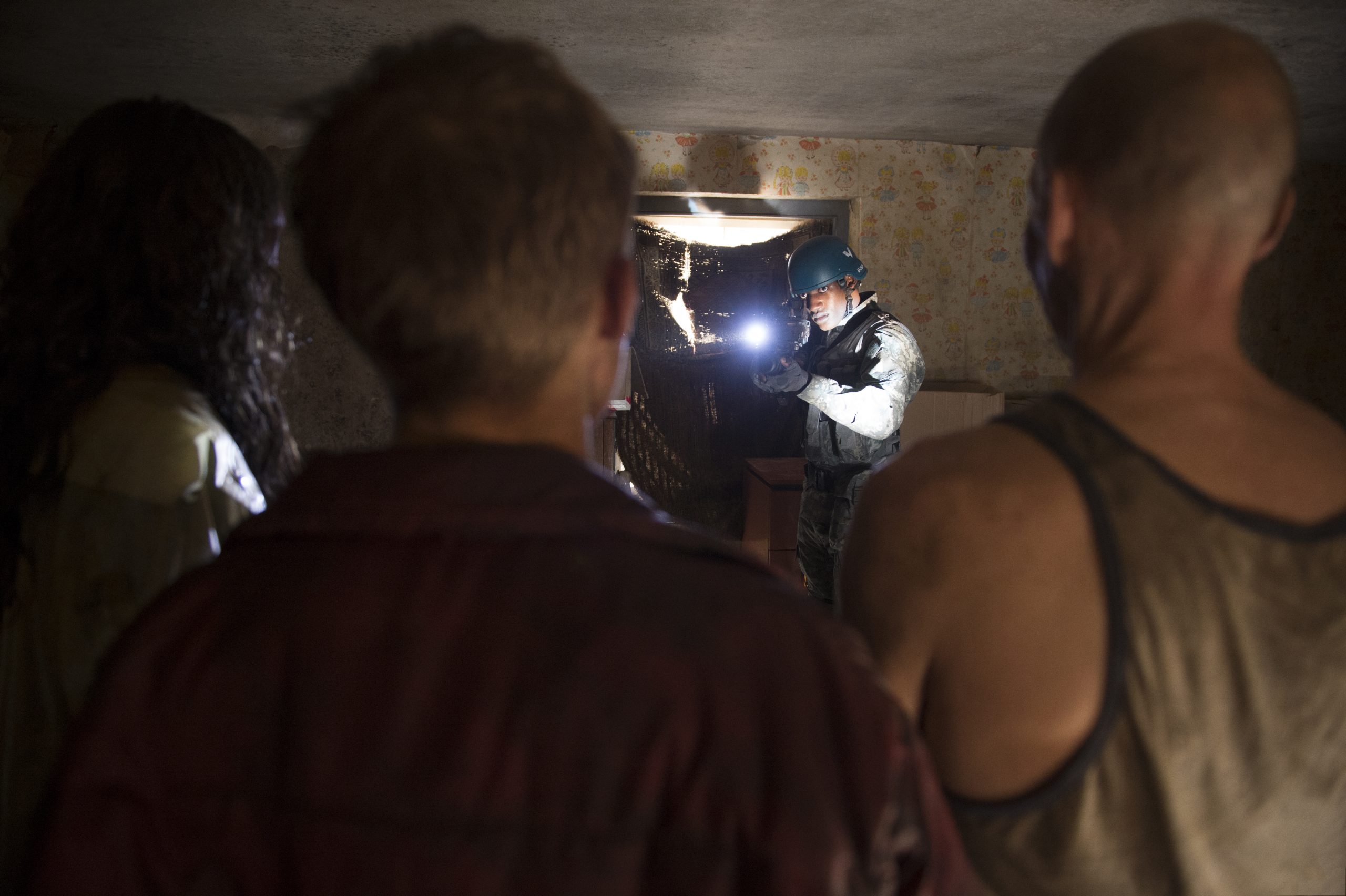
Men Against Fire is the fifth episode of the third series of British science fiction anthology series Black Mirror, written by Charlie Brooker and directed by Jakob Verbruggen in 2016. The episode follows Stripe, a soldier implanted with an advanced Augmented Reality device that could help efficient killing without perception. The impressive core conflict of Men Against Fire is the progressiveness agenda dominated by the government, accompanied by the ethnic cleansing of the inferior group. Arquette, the military psychiatrist, attempts to justify the legitimacy of the massacre on ‘roaches’ —that is how they name the inferior people—with eugenic theory to reply to the outrage of Stripe when the young soldier understands the truth about MASS. Using the audience’s intense emotional connection with Stripe, Men Against Fire brings the question of whether the advanced devices—especially the Augmented Reality equipment that is capable to ‘blend the real and the algorithmic’ (Nelly, 2018; Pesce, 2021, p.8)—would become an accomplice to unjust owners.

Augmented Reality devices might become the brainwashing tool by the designers.
The question of technology ethics might be meaningless without the focus on the design phase. The bilateral interaction between the consensus of social values and the process of designing and developing of technology (Sharma et al., 2015, p.21) make social ethics vital criteria when designers inspect their production (Shilton, 2013), hence Steele et al. (2020, p.225) argue that the AR/VR designers and developers could improve their production under the beneficial guidance of interactive practice with the early users. Through self-observation (Skinner, 1965) and cognitive dissonance (Festinger, 1957, as cited in Steele et al., 2020)—two theories respectively interpret how individuals generate the perception of reality—early users would share their attitude of the acceptable moral scope after the interaction with (augmented/ virtual) reality in the beta-testing phase, which is deemed a valuable suggestion for the production perfection.
However, such process is based on an optimistic assumption that might be deviated from reality: dominant designer might not set the moral criteria of AR/VR devices to meet social values as a ‘service provider’ but plays the role of ‘despot’, utilizing users’ feedback to control their mentality by avoiding or manipulating the unacceptable reality. In Men Against Fire, the designer of the MASS system manipulates the reality in soldiers’ perception: according to the vampire-like looks and high-pitched squeaks designed by the MASS, soldiers would think of the inferior human as aggressive monsters hence killing them without any moral guilty.
MASS system plays the role of convenient brainwashing equipment by the government; it has consistent principle and purpose with political propaganda and ideology campaign by Nazism but functions in a more concealed and unconscious approach. However, at least the Nazi acknowledges that they are doing the ethnic cleansing, they have the faith that the holocaust of Jews is for the human genre progressiveness rather than simply for fun; While the situation would significantly differentiate once soldiers wear MASS: soldiers in Men Against Fire constantly and undisguisedly shows their interest on killing Roaches, which embodies in their praise on Stripe’s first-two killing as ‘lucky terminator’. Even individual as kind-hearted as Stripe who believes ‘who shoot a civilian, that is gonna stay with whose rest of your life’ would shoot at others without hesitation under the guidance of such Augmented Reality devices. If Germany’s free will in WWII is deemed as being ‘controlled’, then the one of soldiers in Men Against Fire is completely ‘substituted’ by the MASS. The soldiers themselves thoroughly reduce to the tools of designers in the Augmented Reality era.

Augmented Reality opens up the New World, technological colourization follows
The ownership of Augmented Reality devices might become the ruling tool according to its overwhelming power. The government in Men Against Fire successfully establishes an autocracy that soldiers are brainwashed into killing machines, and the so-called inferior people are deprived of the identification of human-being and the basic right to survive. The government’s achievement is largely attributed to its capacity and power to augment the real world. As Augmented Reality is the expansion and extension of a particular physical space (Nelly, 2018), each corporation and authoritarian nation would greedily seek for their dominion the command over the new world (Pesce, 2021, p.10), just as how the military in Men Against Fire does.
A colourful new world explored on the mundane white wall on Facebook’s industrial-looking campus exemplified a similar situation. as Facebook could rewrite every visible surface by their AR technology, they have the power to manipulate individual perception hence control the future (Pesce, 2017, p.76). That is to say, whoever holds the brush that can modify the new world would be the ruler of the new era. The anxiety of Pesce is depicted in Men Against Fire, the ethnic cleansing reflects not only the military power gap between the army and ‘roaches’ but the difference of discourse power behind as dominant group gains the power to define which groups are the ‘roaches’. The slaughter on ‘roaches’—who are human beings—by Stripe’s squad reminds audiences of those famous mass killings and genocide by the name of the progressive future (McSweeney & Joy, 2019, p.164), for instance, The Holocaust of six million Jews by the Nazi regime or Jallianwala Bagh Massacre carried out by British colonists in India. It could be concluded that MASS—following the instruction of its designers—contributes to the colonization and genocide.
The story of Men Against Fire ends with the surrender of Stripe, who finally obeys to massacre on ‘roaches continually’, but the situation could be even worse: what if the establishment just modifies several parameters of MASS then immediately make the soldiers turn their guns to the leader of the democratic revolution? What if the authorities popularize the application of MASS to the public and ultimately result in the loss of free will on collective dimension? Similar concerns are mentioned in movies and literature such as the illusion world in The Futurological Congress (a fictional novel in 1971 by Polish author Stanisław Lem) and the famous choice between red and blue pills in The Matrix (a series of science fiction action film in 1999 and 2003). These works of art echo Huxley’s fable, revealing that advanced technology would inevitably lead people into an illusion world, which is an actual Brave New World ruled by the tech-dominant group who can control the mass by Augmented Reality.
“A really efficient totalitarian state would be one in which the all-powerful executive of political bosses and their army of managers control a population of slaves who do not have to be coerced, because they love their servitude.”― Brave New World
Pesce (2021, p.14) use ‘colonization’ to describe how AR influence public lives, commenting on the crowd in Peg Paterson Park. As the development of Augmented Reality provides a new possibility people precept the world, nations and firms would fight for the discourse power in the new world, which would recreate the exploitation and colonization inspired by The Age of Exploration.
Augmented Reality erases the last trace of empathy on the battlefield.
Another potential issue would happen on the battlefield, questioning whether AR would lead to a less humanistic war form. Battlefield is supposed to be a concern as AR devices have been introduced into Marines and the Air force. Men Against Fire shows several functions of MASS, including real-time information sharing and remote-operating of UAV; the most controversial feature among them is that the devices could conceal the brutality of killing—soldier with the implant neither can smell blood nor heard the begging for mercy, the loud sound of guns would also be processed into a more electronic and unreal one. All of these are aimed at a more efficient war form, in other words, abandon empathy and killing decisively in response to the issues presented in the book Men Against Fire by S.L.A. Marshall (the origin of this episode’s name). Although AR device is serviceable to ‘present trainees with decision-inducing scenarios’ (Sheridan, 2019) or connecting remotely experienced surgeons to improve treatment of combat trauma injuries (Andersen et al., 2017), the result of MASS would be a caution to the military that such AR devices could be a relentless weapon against humanitarianism.
Conclusion
The episode recalls the question on technology ethics; the issue would be more severe than the period of computer or cell phone as the ability of AR to edit the reality and impact on human’s perception. Whether the AR Arts by Zuckerberg or the AR goggles sold to the army by Microsoft, it shows that tech giants have begun to compete in the AR area. The situation appeal to detailed laws and regulations that are supposed to be implemented for the created AR world.
References list
Andersen, D., Popescu, V., Cabrera, M. E., Shanghavi, A., Mullis, B., Marley, S., Gomez, G., & Wachs, J. P. (2017). An Augmented Reality-Based Approach for Surgical Telementoring in Austere Environments. Military Medicine, 182(S1), 310–315. https://doi.org/10.7205/MILMED-D-16-00051
Carmigniani, J., Furht, B., Anisetti, M., Ceravolo, P., Damiani, E., & Ivkovic, M. (2011). Augmented reality technologies, systems and applications. Multimedia Tools and Applications, 51(1), 341–377. https://doi.org/10.1007/s11042-010-0660-6
McSweeney, T., & Joy, S. (2019). Through the Black Mirror: Deconstructing the Side Effects of the Digital Age. Springer International Publishing AG.
Neely, E. L. (2019). Augmented reality, augmented ethics: who has the right to augment a particular physical space? Ethics and Information Technology, 21(1), 11–18. https://doi.org/10.1007/s10676-018-9484-2
Pesce, M. (2017). The last days of reality. Meanjin (Melbourne, Vic. : 1977), 76(4), 66-81.
Pesce, M. (2021). Augmented reality : unboxing tech’s next big thing . Polity Press.
Sharma, S., Lomash, H., & Bawa, S. (2015). Who regulates ethics in the virtual world? Science and Engineering Ethics, 21(1), 19–28. https://doi.org/10.1007/s11948-014-9516-1
Sheridan, E. (2019). Remaining Semper Paratus: Augmented Reality in the Coast Guard. Performance Improvement (International Society for Performance Improvement), 58(6), 6–11. https://doi.org/10.1002/pfi.21880
Shilton, K. (2013). Values Levers: Building Ethics into Design. Science, Technology, & Human Values, 38(3), 374–397. https://doi.org/10.1177/0162243912436985
Skinner, B. F. (1965). Science and human behavior. Free Press.
Slater, M., & Sanchez-Vives, M. V. (2016). Enhancing Our Lives with Immersive Virtual Reality. Frontiers in Robotics and AI, 3. https://doi.org/10.3389/frobt.2016.00074
Steele, P., Burleigh, C., Kroposki, M., Magabo, M., & Bailey, L. (2020). Ethical Considerations in Designing Virtual and Augmented Reality Products—Virtual and Augmented Reality Design With Students in Mind: Designers’ Perceptions. Journal of Educational Technology Systems, 49(2), 219–238. https://doi.org/10.1177/0047239520933858
![]()
This work is licensed under a Creative Commons Attribution-NonCommercial-ShareAlike 4.0 International License.


